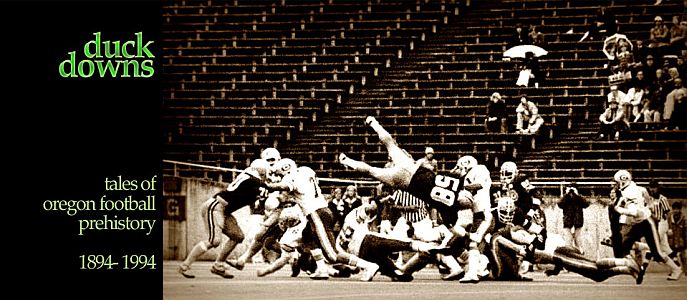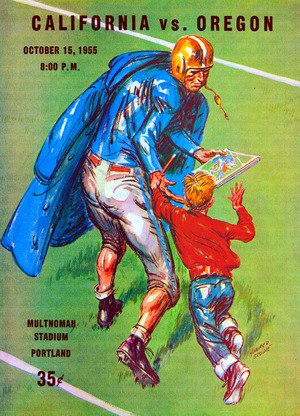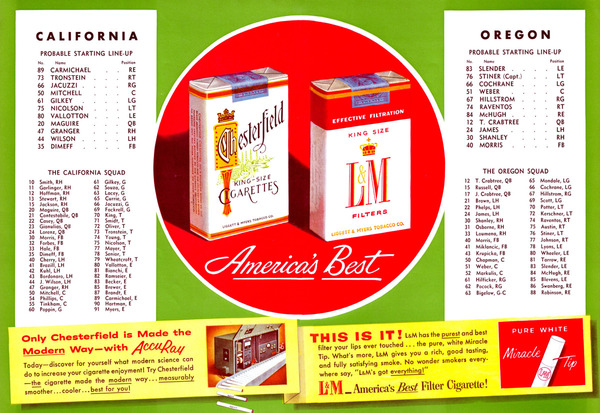November 3, 1928 – Oregon at California
 October 11, 2011
October 11, 2011 “The state of California is well represented on the University of Oregon football team which plays the Golden Bears today. Six of the forty men on the squad are registered from the Golden State.”
 Johnny KitzmillerYes, there was a time when six of 40 would be considered solid representation from California. That time was the Roaring Twenties, from whence this program has survived. The oldest entry in the Program Project (so far) dates from midseason of 1928, when John J. “Cap” McEwan’s squad was on the way to the best record in school history, but came up empty at Berkeley.
Johnny KitzmillerYes, there was a time when six of 40 would be considered solid representation from California. That time was the Roaring Twenties, from whence this program has survived. The oldest entry in the Program Project (so far) dates from midseason of 1928, when John J. “Cap” McEwan’s squad was on the way to the best record in school history, but came up empty at Berkeley.
The Cal game was, then as now, a serious test and a crucial conference matchup. Oregon, at 4-1 with only a loss to powerful Stanford, was seen as a team with an outside shot at a Rose Bowl bid. But the Bears had superior talent at ends, their backfield was a match for Oregon despite the presence of All-Conference QB Johnny Kitzmiller, and ultimately the massive linemen of the Ducks bogged down in the quagmire of Memorial Stadium’s muddy turf. Oregon never got close to the Cal goal, despite some cunning attempts (below) and lost 13-0.
 John J. “Cap” McEwanUltimately, the Oregon loss was but one in a string of six consecutive shutouts amid a thirteen year winless streak against Cal. As for the Bears, they had everything arranged in their favor – an absurdly biased schedule with eight of nine games at home helped – and the season ultimately came down to the Big Game; that 13-13 tie put Cal in Pasadena for New Year’s Day, where they lost to Georgia Tech 8-7.
John J. “Cap” McEwanUltimately, the Oregon loss was but one in a string of six consecutive shutouts amid a thirteen year winless streak against Cal. As for the Bears, they had everything arranged in their favor – an absurdly biased schedule with eight of nine games at home helped – and the season ultimately came down to the Big Game; that 13-13 tie put Cal in Pasadena for New Year’s Day, where they lost to Georgia Tech 8-7.
Oregon didn’t lose another game, including two holiday contests in Honolulu against the University of Hawaii and a team of island all-stars, and finished the season 9-2.
Program Notes:
- No Oregon team had won nine games in a season before 1928; the feat would be repeated in 1933 and 1948, and not again until 1994.
- Johnny Kitzmiller, the “Flying Dutchman”, was the star of Cap’s charges. The native of Harrisburg, Pennsylvania had originally planned to matriculate at West Point, but when McEwan bolted the Black Knights for points west in 1926, Kitzmiller changed his plans and followed a year later. Kitzmiller later followed his coach into the College Football Hall of Fame; McEwan was inducted in 1962, for his play as a lineman at Army, and Kitzmiller in 1969.
- Berkeley Daily Gazette pregame notes:
“Last year the Webfooters were a doormat for the entire conference but … McEwan had his teeth pulled this year and since that time his team has begun to look like the old Oregon machines that put fear into the hearts of all opponents … If McEwan is wise he will have a leg amputated or his tonsils cut out before the California game tomorrow, if having his teeth pulled could improve the Webfooters so much.. If [Cal coach] Price knows his stuff … he will keep watch on all the hospitals tonight and find out whether or not McEwan is going to have another operation.” - Berkeley Daily Gazette postgame report:
“The stands got quite a thrill in the fourth quarter when an Oregon end tried to get away with the ancient dead man play. The ball was on the east edge of the field and the Webfoot wingman sneaked over to the opposite side and stretched out on the ground. His jersey was muddy and California didn’t see him. For some unknown reason Oregon delayed in calling signals while 30,000 fans signaled, called and prayed for the Bears to wake up and find him. They finally did and McEwan, Oregon’s coach, ruined a perfectly good hat by throwing it forcibly down on the muddy stadium field.” - Note the photograph of Cap McEwan on page 4, with the cowlick. Up until around 1930 it was not unusual for coaches — especially coaches who had played the game — to wear the uniforms of their teams during practice, in case they’d have to demonstrate playing technique on the field. The practice apparently didn’t extend to game day, however, when coaches of the era would don suits, topcoats and fedoras. Personally, I’d like to see Chip Kelly wearing an Oregon uniform sometime.
- The “Penalties” page reveals more oddities of the era. See #14: “Feint to snap ball… 5 yards.” So, an attempt to draw the defense offsides was considered a violation?
- Only one sponsor in this Cal-published program, on the back cover; brought to you by the then-ubiquitous Richfield Oil Company of California.
- Program is on the small side, 9” x 5.5”.
 college football programs in
college football programs in  1928,
1928,  California
California 









